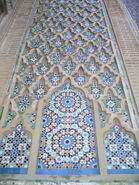
Zellige used for a fountain
Zellige, zillij or zellij (Arabic: الزليج) is terra cotta tilework covered with enamel in the form of chips set into plaster.[1] It is one of the main characteristics of the Moroccan architecture. It consists of geometrical mosaics made from ceramic used mainly as an ornament for walls, ceilings, fountains, floors, pools, tables, etc.
History[]
The art of zellige flourished at the Hispano-Moresque period (Azulejo) of Morocco. The art remained very limited in use until the Merinid dynasty who gave it more importance around the 14th century and introduced blue, green and yellow colours. Red was added in the 17th century. The old enamels with the natural colours were used until the beginning of the 20th century and the colors had probably not evolved much since the period of Merinids. The cities of Fes and Meknes remain the centers of this art.
Patrons of the art used zellige historically to decorate their homes as a statement of luxury and the sophistication of the inhabitants. Zellige is typically a series of patterns utilizing colorful geometric shapes. This framework of expression arose from the need of Islamic artists to create spatial decorations that avoided depictions of living things, consistent with the teachings of Islamic law.
Forms and trends[]
The colour palette of the zellige started to grow rich by colors which make it possible to multiply the compositions ad infinitum (see picture above). The most current form of the zellige is the square one whose dimensions are variable. Other forms are also possible in composition: the octagonal combined with a cabochon, a star, a cross, etc. It is then molded with a thickness of approximately 2 centimeters. There exists in simple squares of 10 per 10 centimeters or with the corners cut to be combined with a coloured cabochon. To pave the grounds, bejmat, a paving stone of 15 per 5 centimeters approximately and 2 centimeters thick, can also be used.
Themes often employ Kufic script, as it very nicely fits with the geometry of the mosaic tiles, and patterns often culminate centrally in the Rub El Hizb. The patterns evinced in the mosaics is currently of interest in academic research in mathematics. Considerable research into modeling of these patterns has taken place.
These studies require expertise not only in the fields of mathematics, art and art history, but also of computer science, computer modeling and engineering as well,[2] as this has been done in the Hassan II Mosque.
Zellige craftsmanship[]
Zellige making is considered an art in itself. The art is transmitted from generation to generation by maâlems (master craftsmen). A long training starts at childhood in order to master exceptional skills.[3]
Assiduous attention to detail is very important in the process of creating zellige works. The small shaped (cut according to a precise radius gauge), painted and enamel covered pieces are then assembled together in a geometrical structure as in puzzle to form the completed single mosaic. The process has not varied for a millennium, though conception and design has started using new technologies such as data processing.[citation needed]
See also[]
References and notes[]
- ↑ L'Opinion (May 6, 1992)
- ↑ *From Form to Content: Using Shape Grammars for Image Visualization, Source IV archive Proceedings of the Ninth International Conference on Information Visualisation (IV'05) - Volume 00, IEEE Computer Society Washington, DC, USA
- ↑ beton-decoratif.com
- Some of the content of this article comes from the equivalent French-language Wikipedia article, accessed January 3, 2007.
- Moroccan Ceramics and the Geography of Invented Traditions, Journal article by James E. Housefield; The Geographical Review, Vol. 86, 1997
- The Elements of Unity in Islamic Art As Examined Through the Work of Jamal Badran, By Fayeq S Oweis
- Engineering and fine arts research collaborations sprout from seed grants, By Scott McRae, Concordia's Thursday Report, Vol. 29, No.1, September 9, 2004
- Technical Glossary, Islamic Art Network, Thesarus Islamicus Foundation, Islamic Art Network 21 Misr Helwan al-Ziraa‘i St., 9th Floor, Al-Ma'adi, Cairo, Egypt
External links[]
- Zellige is kind of art which is typically Moroccan
- Handmade zellige and Moroccan mosaic images
- Moroccan Mosaics: Art of Zillij (Zellige)
| Esta página tiene contenido de Wikipedia. El Artículo original es Zellige. La lista de autores la puedes ver en Historial. El texto de Wikipedia esta disponible bajo Licencia Creative Commons Atribución/Compartir-Igual 3.0. |




